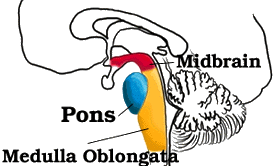Brain Stem Injury Capable of Causing Death and Terrible Damage
What an Injured Brain Stem Means
By Gordon S. Johnson, Jr.
Brain Stem Injury is often terrible because damage to the brain stem involves injury to the autonomic nervous system, which controls heart and breathing. Stopping the heart or respiration will cause death. While brain stem injury can occur directly from trauma, the chief concern in most severe brain injuries is the risk of herniation of the cerebral cortex into the brain stem area.Herniation of the Brain Stem in Severe Brain Injury

The brain stem is made up of the Midbrain, the Pons and the Medulla Oblongata.
Herniation is a term that means to bulge out. Most people will have first heard this term used to apply to disk herniations in the spine. A herniation of the brain into the skull involves a pushing out of the brain into the cavity of the skull where the brain stem resides. Pushing out of the brain into this space will squeeze the brain stem. When the brain stem is compressed, breathing and blood pressure can be disrupted, causing death.
The brain stem is in the most inner part of the lower brain, and includes the Midbrain, Pons and Medulla Oblongata, as seen in the diagram.
The Midbrain
The Midbrain, is also called the mesencephalon. The midbrain or mesencephalon is on the top part of the brainstem, as shown in the diagram. The midbrain is the part of the brain stem that is nearest to the cerebral cortex. The midbrain splits into an anterior and a posterior section. Motor tracts (the axonal tracts which control the muscles) pass along the midbrain’s frontal surface. Sensory axons which communicate the sense of touch and other senses run behind the motor tracts.
The Pons
The Pons is located underneath the Midbrain and on top of the Medulla Oblongata. Motor and sensory axonal tracts are found along the front of the Pons. The sensory axons are found behind the motor axons in the Pons. The tracts of Cranial Nerve V and Cranial Nerve VI (CN V and CN VI) are found in the Pons. CN V which is the trigeminal nerve, delivers signals to the jaw and accepts messages from the tongue, teeth and parts of the face. CN VI, the abducens nerve, sends motor commands to the eye.
The nucleus of CN VII, the facial nerve, is on the edge of the Pons and Medulla Oblongata. The highest part of the nerve controls the muscles for facial expression, eye lids, the forehead and the lips. The lowest part of CN VII controls the voluntary muscles of the face underneath the eyelids.
The Medulla Oblongata
The Medulla Oblongata is found in the deepest part of the brain stem. The cell nucleus of several other cranial nerves are located in the Medulla Oblongata.